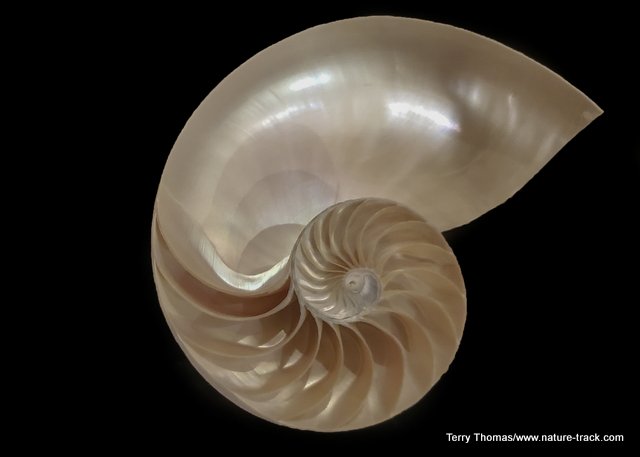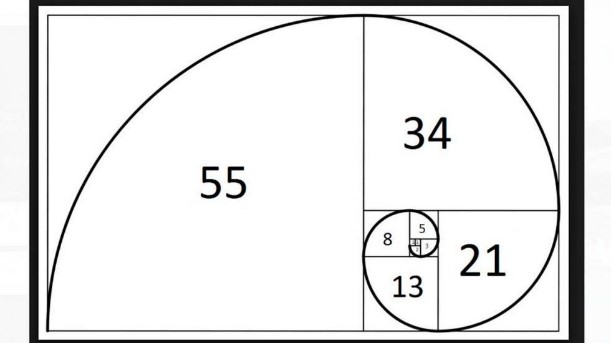Golden Ratio in Nature

This nautilus shell demonstrates a perfect golden ratio spiral.
Are there patterns in nature? There are likely many, as successful patterns tend to be repeated. However, there is one pattern that is very recognizable and is found in a variety of organisms and even inorganic things like funnel clouds and galaxies. It is called the golden ratio and has a mathematical base.
The golden ratio is simply 1.6180339887498948482...(an infinite number) or its inverse, 0.618.... and is represented by the Greek letter, phi ɸ. The ratio is this: with the line, A____________C_________B, if AB/AC=AC/CB (the ratio of line AB to AC is the same as the ratio of line AC to CB) it is a golden ratio.
How it is achieved and how it applies take a bit of explaining. Start with the Fibonacci sequence. This is an infinite series of numbers derived from adding a sequence of numbers this way: 1, 0+1=1, 1+1=2, 1+2=3, 2+3=5, 3+5=8, 5+8=13, 8+13=21, 13+21=34, 21+34=55 and so on, where each number in the sequence is the sum of the two numbers that precede it. Each summed number is a Fibonacci number (1, 2, 3, 5, 8, 13, 21, 34, 55 and so on) and the ratio between the numbers is the golden ratio.
One application of this sequence creates spirals in nature that are precise and functional. To best illustrate this, start with a single square, 1x1 inch. Next to it, add to it a second 1x1 box forming a 1x2 rectangle. On top of this, add a 2x2 inch square, forming a rectangle 3 inches tall by 2 inches wide. On the side of this, add a 3x3 inch square, forming a new rectangle, 3x5 inches. Now add another square, this one 5x5 inches, forming a rectangle 5x8 inches. Continue as long as you want. It should look something like this:

When you run an arc through opposite corners of each square, a specific spiral occurs. That is cool, and it turns out that nature uses this spiral in many designs. The most commonly used example is the shell of the sea creature called a nautilus. While some mathematicians argue (they rarely agree on anything) that the distance measurement between the curves is logarithmic and not Fibonacci, the curve itself perfectly aligns with the shell.
Other well-known examples of a Fibonacci sequence and the golden ratio include the seeds in the head of a sunflower, the scales on a pinecone and the rings on the outside of a pineapple. Many seashells also show this curving design. Not only do they have the spiral pattern, the numbers of curves are almost always (very little is ever absolute in nature) Fibonacci numbers. For instance, the cone of a ponderosa pine in my collection has 13 spirals one direction and 8 in the other direction.
Flowers often have Fibonacci-numbered petals and leaves. And even the leaf arrangement is derived from what is considered the golden angle, 137.5 degrees. When leaves are oriented in this fashion, all the leaves receive maximum exposure to sunlight without being shaded excessively by neighboring leaves. It is not that the plants have an internal ruler, but growth inhibitors do keep the leaves from growing too close to each other and over time plants have found this perfect angle.
For eons, humans have either inadvertently or purposely built using the golden ratio. Many ancient places, including some of the pre-Columbian structures at Mesa Verde National Park, are built upon multiples of the golden ratio.
When you observe carefully, you will find the golden ratio and the Fibonacci sequence in many aspects of nature. Of course, it isn’t the only design out there, but it is a fascinating one and lends credence to the concept of an intelligent design. I can’t begin to do justice to this topic in the space allotted, so, for more on the subject, I refer you to the clever and entertaining three-part series by Vi Hart: https://www.youtube.com/watch?v=ahXIMUkSXX0, and, It’s Okay to be Smart’s presentation on the same subject: https://www.youtube.com/watch?v=1Jj-sJ78O6M.
Help Idaho Wildlife
When we traveled across the state in October 2017, we visited most of the Idaho Department of Fish and Game wildlife management areas. Most of the vehicles we saw using the wildlife management areas did not have wildlife plates. Buying wildlife plates is a great way for non-hunters and hunters alike to support wildlife-based recreation like birding.
C'mon folks, let's help Idaho's wildlife by proudly buying and displaying a wildlife license plate on each of our vehicles!
See below for information on Idaho plates. Most states have wildlife plates so if you live outside Idaho, check with your state's wildlife department or vehicle licensing division for availability of state wildlife plates where you live.
And tell them that you heard about it from Nature-track.com!

Wildlife License Plates
Great news! as of 2024, there are three NEW designs for license plates. They still are bluebird, cutthroat trout and elk, but they are beautiful.
Idaho Wildlife license plates provide essential funding that benefits the great diversity of native plants and wildlife that are not hunted, fished or trapped—over 10,000 species or 98% of Idaho’s species diversity. Game species that share the same habitats (such as elk, deer, antelope, sage-grouse, salmon, trout) also benefit from these specialty plates.
No state tax dollars are provided for wildlife diversity, conservation education and recreation programs. Neither are any revenues from the sale of hunting or fishing licenses spent on nongame species. Instead, these species depend on direct donations, federal grants, fundraising initiatives—and the Idaho Wildlife license plates.
Both my vehicles have Bluebird Plates. I prefer the bluebird because the nongame program gets 70 percent of the money from bluebird plates, but only 60 percent of the money from elk and trout plates - 10 percent of the money from elk plates supports wildlife disease monitoring and testing programs (to benefit the livestock industry) and 10 percent from cutthroat plates supports non-motorized boat access.
Incidentally, in 2014, the Idaho Legislature denied the Department of Fish and Game the ability to add new plates or even to change the name of the elk and cutthroat plates (very specific) to wildlife and fish plates, a move that would have allowed for changing images occasionally and generating more revenue. It would seem that they believe that we Idahoans don't want a well funded wildlife program.
I think it is time we let the Legislature know that Idahoan support wildlife funding and that we would like to see these generic plates come to fruition.

"WOW. What a phenomenal piece you wrote. You are amazing." Jennifer Jackson
That is embarrassing, but actually a fairly typical response to my nature essays. Since The Best of Nature is created from the very best of 16 years of these nature essays published weekly in the Idaho Falls Post Register (online readership 70,000), it is a fine read. It covers a wide variety of topics including humorous glimpses of nature, philosophy, natural history, and conservation. Readers praise the style, breadth of subject matter and my ability to communicate complex and emotional topics in a relaxed and understandable manner.
Everyone can find something to love in this book. From teenagers to octogenarians, from the coffee shop to the school room, these nature essays are widely read and enjoyed.
Some of the essays here are my personal favorites, others seemed to strike a chord with readers. Most have an important message or lesson that will resonate with you. They are written with a goal to simultaneously entertain and educate about the wonderful workings of nature. Some will make you laugh out loud and others will bring a tear to the eye and warm your heart.
Readers Write:
"You hit a home run with your article on, Big Questions in Nature. It should be required reading for everyone who has lost touch with nature...great job!" Joe Chapman
"We enjoyed your column, Bloom Where Planted. Some of the best writing yet. The Post Register is fortunate to have your weekly columns." Lou Griffin.
To read more and to order a copy, click here or get the Kindle version
Copies are also available at:
Post Register
Island Park Builders Supply (upstairs)
Barnes and Noble in Idaho Falls
Harriman State Park, Island Park
Museum of Idaho
Valley Books, Jackson Wyoming
Avocet Corner Bookstore, Bear River National Wildlife Refuge, Brigham City, Utah
Craters of the Moon National Monument Bookstore, Arco, Idaho
Wildlife License Plates
Great news! as of 2024, there are three NEW designs for license plates. They still are bluebird, cutthroat trout and elk, but they are beautiful.
Idaho Wildlife license plates provide essential funding that benefits the great diversity of native plants and wildlife that are not hunted, fished or trapped—over 10,000 species or 98% of Idaho’s species diversity. Game species that share the same habitats (such as elk, deer, antelope, sage-grouse, salmon, trout) also benefit from these specialty plates.
No state tax dollars are provided for wildlife diversity, conservation education and recreation programs. Neither are any revenues from the sale of hunting or fishing licenses spent on nongame species. Instead, these species depend on direct donations, federal grants, fundraising initiatives—and the Idaho Wildlife license plates.
Both my vehicles have Bluebird Plates. I prefer the bluebird because the nongame program gets 70 percent of the money from bluebird plates, but only 60 percent of the money from elk and trout plates - 10 percent of the money from elk plates supports wildlife disease monitoring and testing programs (to benefit the livestock industry) and 10 percent from cutthroat plates supports non-motorized boat access.
Incidentally, in 2014, the Idaho Legislature denied the Department of Fish and Game the ability to add new plates or even to change the name of the elk and cutthroat plates (very specific) to wildlife and fish plates, a move that would have allowed for changing images occasionally and generating more revenue. It would seem that they believe that we Idahoans don't want a well funded wildlife program.
I think it is time we let the Legislature know that Idahoan support wildlife funding and that we would like to see these generic plates come to fruition.